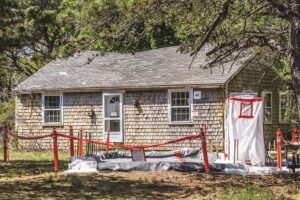TRURO — By the end of June, the Cape Cod National Seashore will be about three-quarters of the way through its demolition of 44 buildings — an undertaking being carried out with $8.3 million in federal funds through the Great American Outdoors Act.

“Most were pretty much beyond repair, dilapidated, and some of them have roofs or other parts of the building caving in,” Park Planner Lauren McKean told the Independent.
Twenty-five of the buildings in question are at the Highland Center, the former North Truro Air Force Station, and became property of the National Park Service when the base was retired in the 1990s. The rest of the properties are houses acquired decades earlier, in the 1960s and ’70s, shortly after President John F. Kennedy signed the bill authorizing the establishment of the Cape Cod National Seashore in 1961, according to a description of the project posted on the Park Service’s website.
Not all the buildings were inhabitable when they were transferred to the Park, said McKean. “Some of them were in very bad shape by the time we got them, so they just got worse,” she said.
After the deteriorating structures are razed, “the sites will be restored and allowed to become part of the surrounding landscape,” McKean said.
In addition to the 25 buildings at the Highland Center and three other houses in Truro, the buildings being taken down are scattered around Wellfleet — near Newcomb Hollow Beach and the kettle ponds, and two in Wellfleet’s Herring River floodplain — and in Eastham, along the Nauset inlet.
The Eastham trio, on Tomahawk Trail, are mixed in among newer homes and enjoy an expansive view of the water. But the buildings have become dangerously deteriorated and their lots so overgrown with brush that they are nearly inaccessible.
Eastham Building Commissioner Justin Post said it was a challenge, but he was able to inspect the interiors of all three houses. “It looked like only raccoons and squirrels were going in there to party,” Post said, based on the scattering of nuts and poop left behind.
Seashore officials conferred with Peter McMahon, director of the Cape Cod Modern House Trust, to make sure none of the architecturally significant midcentury modern houses tucked into the landscape of the Outer Cape were on the demolition list.
“There was one of interest in Truro, but it was too far gone,” said McMahon. The trust’s mission is to preserve the midcentury houses when possible. It has restored four historic houses to date and is currently working to purchase a house in Wellfleet that was designed by Marcel Breuer.
McMahon said Seashore officials offered the trust a lease on an abandoned contemporary house on Doane Road in Eastham, but the organization declined. That house is not among those targeted for demolition.
The removal of two dilapidated houses near the restored Kohlberg house on Wellfleet’s Ocean View Drive was thoroughly done, said McMahon, leaving the properties clear of debris and ready for their return to nature.
Demolition and site work will continue until the end of June, when the project will pause for the summer. Contractors will resume their work on the last group of properties to be demolished in September. The Park forecasts the razing project will be complete by spring of 2024.
Bob Weinstein, who lives on Dyers Hollow Road in Truro, was alarmed to find a house at the end of his road being demolished as part of the Seashore’s project.
“What I think is outrageous is we’re supposedly having a housing crisis and what are they doing?” said Weinstein. “They’re taking down houses that could have been utilized if they’d been properly maintained.” He said the razing makes the lack of available local housing “a self-inflicted crisis.”
Weinstein remembered the years when the building in question was used as housing for Park staff. “It was a viable year-round house,” he said.
McKean confirmed that the house on Dyers Hollow Road had in the past been used for housing seasonal Seashore staff members. But “it had been sitting for a decade or so vacant and just getting in worse and worse shape,” said McKean.
Terry Strock, an employee of Cherokee CRC LLC — the small Tulsa, Okla.-based business contracted to carry out the demolition — is by now familiar with all 44 structures the Park says are “nonhistoric” and ready to come down. Strock described the buildings as “unmaintained for years — that’s what it looked like to me.” He said that none of the buildings seemed repairable.
“Roof damage and an unstable structure” are, Strock said, what make the Dyers Hollow Road house uninhabitable.
As part of the demolition project, contractors are also performing hazardous materials abatement before tearing down the buildings. Asbestos is the main issue, according to McKean. Strock said that a subcontractor is doing most of the hazard abatement. According to the NPS website, that subcontractor is Select Demo LLC, based in Salem, N.H.
McKean said the Park Service did consider using the structures for housing staff, but the structures in question “were not an option.” The problem is, she said, “they’d have to be fully rebuilt, and it’s not a redevelopment project. The cost is just too prohibitive.”
Seashore staff members live in 24 permanent houses and 35 seasonal houses in Truro, Wellfleet, and Eastham, according to McKean. Every summer, the seasonal abodes house up to 91 Park employees.



